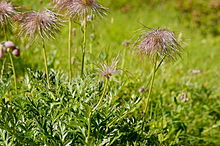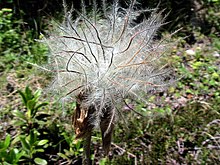Alpine Pasque Flower
| Alpine Pasque Flower | ||||||||||||
|---|---|---|---|---|---|---|---|---|---|---|---|---|

Alpine pasque flower ( Pulsatilla alpina ) |
||||||||||||
| Systematics | ||||||||||||
|
||||||||||||
| Scientific name | ||||||||||||
| Pulsatilla alpina | ||||||||||||
| ( L. ) Delarbre |
The Pulsatilla alpina or Alpine Küchenschelle ( Pulsatilla alpina ), also Alpine Anemone called, is a plant from the genus of Kuhschellen ( Pulsatilla ) within the family of Ranunculaceae (Ranunculaceae).
description

Vegetative characteristics
The Alpine Pasque Flower is a perennial, herbaceous plant that reaches heights of 20 to 50 centimeters. The above-ground parts of the plant are densely hairy.
The basal leaves are not very well developed at the beginning of the flowering period, later they are long-stalked and double three-part. In the upper half of the stem there are three bract-like stem leaves ; which are not grown together at their base.
Generative characteristics
The flowering period extends from May to July, depending on the location. The flowers are solitary and terminal. The hermaphrodite flowers have on the Great Alpine Pasque Flower ( Pulsatilla alpina subsp. Alpina ) and the Yellow Alpine pasqueflower ( Pulsatilla alpina subsp. Apiifolia () diameter 4-6 centimeters, at the Little Pulsatilla alpina Pulsatilla alpina subsp. Austriaca ) from only 2 to 4 centimeters. The inflorescence usually consists of six oval, white or yellow bloom cladding sheets , which are often blue on the outside.
Since the feathery, hairy stylus lengthen to up to 5 centimeters as the fruit ripens, the infructescence of the plant shows a noticeably hair-like appearance - called "Haarmannli" in Switzerland.
The chromosome number is 2n = 16 for the subspecies Pulsatilla alpina subsp. alpina , Pulsatilla alpina subsp. austriaca and Pulsatilla alpina subsp. apiifolia .
Systematics and occurrence
The first publication took place in 1753 under the name ( Basionym ) Anemone alpina by Carl von Linné in Species Plantarum , 1, page 539. The new combination to Pulsatilla alpina (L.) Delarbre was 1800 by Antoine Delarbre in Flore d'Auvergne; ou, Recueil des plantes de cette ci-devant province. Clermont-Ferrand. 2nd edition, page 552 published.
The species Pulsatilla alpina comprises several subspecies, of which at least three occur in Central Europe :
- The Alpine pasque flower or Alpine anemone ( Pulsatilla alpina L. subsp. Alpina ) has white flowers and inhabits areas with calcareous bedrock in the Swiss Jura , in the Alps , the northwestern Dinarides ( Velebit ), in the Apennines , in the Pyrenees and in the Cantabrian Mountains . It thrives at altitudes of 1200 to 2700 meters. In the Allgäu Alps, the Great Alpine Pasque Flower occurs at altitudes from 1500 to 2300 meters.
- The little Alpine pasque flower or Brocken anemone ( Pulsatilla alpina subsp. Austriaca Aichele & Schwegler , Syn .: Pulsatilla alba Rchb. ) With white flowers is smaller in all parts of the plant and occurs on low-calcium rocks in the Carpathian and Eastern Alps as well as in several Central European low mountain ranges ( Vosges , Harz , Riesengebirge ).
- The Yellow Pulsatilla alpina or sulfur Anemone ( Pulsatilla alpina subsp. Apiifolia (Scop.) Nyman ) with sulfur-yellow flowers comes in lime-ground in the western Alps, east to Tyrol , in the Massif Central , the Pyrenees and in some mountain ranges in Central and Northern Spain. The Yellow Alpine Pasque Flower occurs at altitudes of 1,800 to 2,300 meters and only in exceptional cases does it grow at an altitude of 1,620 meters near Häselgehr .
- Pulsatilla alpina subsp. cantabrica M.Laínz : It occurs in the Cantabrian Mountains and in the western Pyrenees.
- Pulsatilla alpina subsp. cyrnea Gamisans : This endemic occurs only in Corsica .
- Pulsatilla alpina subsp. font-queri M.Laínz & P.Monts. : It occurs in Spain and the southern Pyrenees .
Locations
Frequent locations in Central Europe are poor pastures and stony lawns. The large pasque flower occurs on chalky subsoil and in plant communities of the associations caricion ferrugineae and Seserion, while the pasque flower and the yellow pasque flower mostly thrive on soils poor in lime . The Pasque Flower is a character species of the Pulsatillo-Nardetum from the Nardion Association. The Yellow Alpine Pasque Flower occurs in high altitudes in the Aveno-Nardetum from the Nardion Association.
Common names
Original folk names refer to the hairy pods: Grantiger Jager, Haarige Männle, Hexenbesen, Strublbuabn, Tschawau (Upper Styria), Wilde Männle.
For the Alpine Pasque Flower, the names Bärenplumpen ( Graubünden near Rheinwald ), Barentatze ( Carinthia ), Bergmännli ( Bern ), Graues Bergmännle, Bertram ( Bavaria , Pinzgau ), Bitzwurz, Bocksbart (Graubünden) are or were, in some cases only regionally, , Brockenblume or Brocken anemone ( Harz ), Fotzabäsa ( St. Gallen in Obertoggenburg ), Graumannle ( Switzerland ), Hairy Man (Bern), Haarmanteli ( Bernese Oberland ), Kuhschellei (Graubünden), Petersbart (Bavaria), Rugerl ( Tyrol , Pinzgau) , Ruggei (Tyrol, Pinzgau), Ruggeiblüh (Tyrol, Pinzgau), Schaudermann (St. Gallen near Sargans ), snow flowers (Switzerland, Silesia ), snow dealers, snow crows (Silesia), snow roses (Carinthia), white pods, Sidahuat (St. Gallen in the Upper Rhine Valley ), Strubobuobo (Bregenzerwald), devil's beard ( Algän , Silesia) and wild boar are common.
Others
This species is poisonous and is a protected species.
literature
- Holger Zetzsche: The phylogeography of the species complex Pulsatilla alpina (Ranunculaceae) , dissertation, Martin Luther University Halle-Wittenberg, 2004 dissertations at the University and State Library of Saxony-Anhalt in Halle
- Xaver Finkenzeller, Jürke Grau: Alpine flowers (= Steinbach's natural guide . Volume 16 ). Mosaik, Munich 1985, ISBN 3-570-01349-9 .
Individual evidence
- ↑ a b Erich Oberdorfer : Plant-sociological excursion flora for Germany and neighboring areas . With the collaboration of Angelika Schwabe and Theo Müller. 8th, heavily revised and expanded edition. Eugen Ulmer, Stuttgart (Hohenheim) 2001, ISBN 3-8001-3131-5 , pp. 404 .
- ↑ a b Erhard Dörr, Wolfgang Lippert : Flora of the Allgäu and its surroundings. Volume 1, IHW, Eching 2001, ISBN 3-930167-50-6 , pp. 527-528.
- ↑ a b c Jaakko Jalas, Juha Suominen: Atlas florae europaeae. Nymphaeaceae to Ranunculaceae. Volume 8, pages 87-89, Helsinki 1989, ISBN 951-9108-07-6 .
- ^ Georg August Pritzel , Carl Jessen : The German folk names of plants. New contribution to the German linguistic treasure. Philipp Cohen, Hannover 1882, page 27, online.
Web links
- Pulsatilla alpina (L.) Delarbre sl, Alpine pasque flower. In: FloraWeb.de.
- Pulsatilla alpina subsp. apiifolia (Scop.) Nyman, Yellow Alpine Pasque Flower. In: FloraWeb.de.
- Pulsatilla alpina subsp. alpina (L.) Delarbre, Alpine pasque flower (subspecies). In: FloraWeb.de.
- Pulsatilla alpina subsp. alba Kerner ex Zämelis & Paegle, Brocken Pasque Flower. In: FloraWeb.de.
- Pulsatilla alpina subsp. austriaca Aichele & Schwegler. In: FloraWeb.de.
- Alpine Pasque Flower . In: BiolFlor, the database of biological-ecological characteristics of the flora of Germany.
- Profile and distribution map for Bavaria . In: Botanical Information Hub of Bavaria .
- Pulsatilla alpina (L.) Delarbre s. st. In: Info Flora , the national data and information center for Swiss flora . Retrieved October 19, 2015.
- Pulsatilla alpina subsp. apiifolia (Scop.) Nyman In: Info Flora , the national data and information center for Swiss flora . Retrieved October 19, 2015.
- Pulsatilla alpina subsp. austriaca Aichele & Schwegler In: Info Flora , the national data and information center for Swiss flora . Retrieved October 19, 2015.
- Thomas Meyer: Data sheet with identification key and photos at Flora-de: Flora von Deutschland (old name of the website: Flowers in Swabia ).



